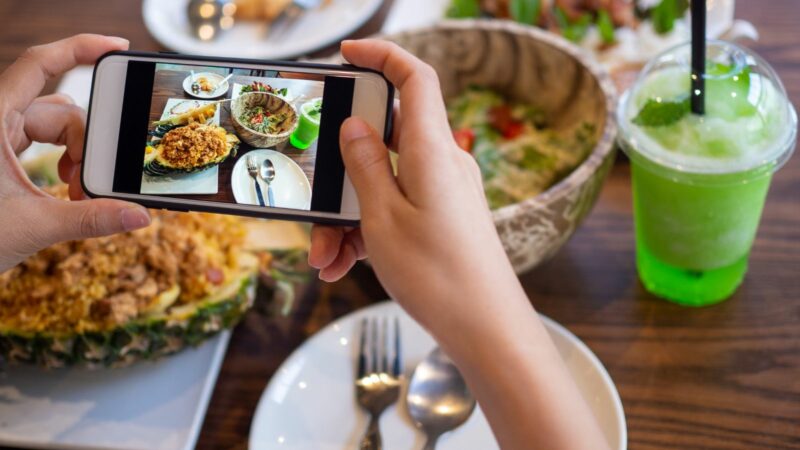In the bustling world of social media, hashtags have become the digital bread crumbs leading us to delectable discoveries. They’re the secret ingredient that spices up our online presence, particularly for food enthusiasts. If you’re a foodie looking to expand your culinary horizons or a restaurant owner aiming to boost your visibility, then you’re in the right place.
 This article unravels the power of trending ‘foodie hashtags.’ We’ll explore how they can transform your food-related posts into viral sensations, attract like-minded food lovers, and even help your business flourish.
This article unravels the power of trending ‘foodie hashtags.’ We’ll explore how they can transform your food-related posts into viral sensations, attract like-minded food lovers, and even help your business flourish.
So, get ready to dive into the mouth-watering realm of foodie hashtags, where every post is a feast for the eyes.
Foodie Hashtags
As a continuation of our broader discussion on hashtags, this section turns its focus on the popularity surge of foodie hashtags within the thriving social media landscape.
What Are Foodie Hashtags?
Foodie hashtags encompass any hashtag used in a social media post related to food. They typically operate as links between posts sharing a common theme, such as appetizing dish imagery (#foodporn), culinary experimentation (#foodieadventures), or restaurant reviews (#eater).
Foodie hashtags’ burgeoning popularity draws from several factors. Firstly, there’s the universal appeal of food: it’s an everyday necessity transformed into a shared pleasure. These hashtags harness the enticing visuals of dishes, thus catching social media users’ eyes. Equally important is the community-building aspect. A simple hashtag can connect users worldwide, grafting a place for shared passions and conversations.
With a staggering 95 million photos shared on Instagram every day, it’s easy to get lost in the crowd. Foodie hashtags provide much-needed visibility, allowing talented home cooks, innovative restaurants and foodies alike to be seen among the clutter of posts.
Analyzing the Impact of Foodie Hashtags
In the buzzing world of social media, foodie hashtags have become the order of the day. From enhancing a restaurant’s reach to accelerating home cooking trends, these digital markers have reshaped the way food finds its audience. Let’s explore this impact more in detail.

Modern restaurants and cafes are not just food establishments; they’re spaces for people to share experiences and create memories. And these delightful experiences derive additional value through the strategic use of foodie hashtags.
For instance, a hashtag such as #tastethisnext incorporated in a post displays their culinary art to an audience well beyond their physical reach.
According to a report by SocialMediaToday, posts using relevant hashtags scored 12.6% more engagement. Foodie hashtags, therefore, act as bridges, connecting restaurants and cafes to a global audience that might otherwise remain unexplored. They help boost the visibility of delectable dishes served, urging potential customers to consider their location for future dine-ins or takeouts.
It’s not just the commercial food establishments that are reaping the benefits of foodie hashtags. Home cooking trends also avail of this advantage. Given our fast-paced lifestyle, coupled with the increased attention to health and wellness, the trends leaning towards home-cooked meals have amplified in recent years.
How to Create Engaging Foodie Hashtags
 Creating engaging foodie hashtags can boost digital visibility, link individual posts to larger food discussions, and enhance the followers’ zeal for culinary exploration.
Creating engaging foodie hashtags can boost digital visibility, link individual posts to larger food discussions, and enhance the followers’ zeal for culinary exploration.
In doing so, materializes an efficient digital marketing strategy with high outreach and engagement benefits. Notably, the process of formulating foodie hashtags differentiates between individuals and businesses, each requiring unique techniques.
Tips for Individuals
Individuals often seek engaging ways to share their culinary adventures, so adding the right kind of hashtags can provide an unexpected thrust.
- Creativity meets relevance: Individuals should design unique hashtags that reflect their personality yet align with their posted content. For example, a protein-focused meal post could incorporate the hashtag “#ProteinParadise.”
- Contextual hashtags are key: Using hashtags relevant to the shared content ensures the post appears in the right searches. E.g., posts featuring homemade sauces might benefit from hashtags like “#HomemadeSauceLove.”
- Include trending hashtags: Tap into existing trends by incorporating commonly used hashtags. This approach helps widen the digital reach; for example, one might include “#FoodPorn” or “#Eeeeeats” in a post featuring an appetizing dish.

